
Hiking Dude Blog
2025 - Aug Jul
2024 2023 2022 2021 2020 2019 2018 2017 2016 2015 2014 2013 2012 2011
01/04/2016
Bridges
 I traveled about 23 miles today.
I traveled about 23 miles today.After a wonderful night of rest, we began our day of waking with a light rain and high hopes for long miles. The rain stopped quickly and was replaced by a strong, steady wind and light overcast all day - prefect weather for walking! But, our miles were cut back due to the pounding our feet and legs are getting from the pavement and concrete. It was a great day with amazing views, splitting the Atlantic and Gulf from bridges over channels. Our biggest challenge of three day was the famous Seven Mile Bridge - along the skinny shoulder with over 1000 cars pet hour flying past. Our early schedule was too ambitious so I'm now figuring a couple of shorter days to allow a bit of recovery. The biggest overall challenge with this trail is figuring spots to spend the night without breaking the bank. The campground tonight charged $60 for a flat spot to pitch a tent. Ouch! Besides the views, my highlight of today was a sandwich at 5 Brothers 2 where we got to listen to a bunch of elderly Cuban friends chat with the owner. Couldn't understand a word, but enjoyed the experience.
01/03/2016
Night into Night
 I traveled about 26 miles today.
I traveled about 26 miles today.Our overnight plane ride got us to Ft. Lauderdale with no trouble and no sleep. Once we found the Avis counter, we got our car with no trouble. Driving down the Keys was an interesting experience. I couldn't help but try to spy out potential camping spots - a very rare item with water and shrubs much more prevalent than firm land. We swapped our car for a crazy pink taxi at the Key West airport and enjoyed a short, expensive ride to the 'southernmost' point of the US. It's pretty amazing how many'southernmost' places there are, from inns to furniture stores. Our hike finally began at the same time as the warm rain. We hiked from key to key until the sun dropped, and then kept going. Our legs were totally exhausted and sore, and I got two bonus blisters. Summerland Key was our destination for the night. I found a couch surfing host who has welcomed us into his home. This is my first couch surfing experience and I'd recommend checking out out. We've been up since yesterday morning so it's time to sign off and hope this night heals the pains for tomorrow's adventure.
01/02/2016
Waiting to Hike
 We're packed and ready.
We're packed and ready.Tomorrow morning, if all goes well, we'll be hiking north from Key West around 11am aiming for Summerland Key. It will be a very, very, very long day.
But, for now, we're just waiting. Phones charged. Trail contacts stored. Important documents printed. Backpacks wrapped up for the plane ride.
The plane is scheduled to leave at 1:15am and arrive in Ft. Lauderdale at 5:40am - not much sleep tonight, not a great way to start a long hike, but the best fit for our schedule. Then, a 3.5 hour rental car ride to Key West airport followed by a taxi ride to the SouthernMost Point and we start hiking.
Feel free to check in on us any time you want at FL Hike page and leave any encouraging comment that you'd like.
Hike On!
12/27/2015
Snow walk
 My 5- mile walk today brought me to this boat landing. In a week we'll be seeing plenty of liquid water instead of all this solid water.
I'm still figuring out some places to spend the night in the FL Keys, but I'm sure it will all work out.
My 5- mile walk today brought me to this boat landing. In a week we'll be seeing plenty of liquid water instead of all this solid water.
I'm still figuring out some places to spend the night in the FL Keys, but I'm sure it will all work out.
Leave Comment
Posted: 12/27/2015
Posted: 12/27/2015
12/11/2015
Florida Hike Prep

 My Florida Trail hike prep is coming along nicely. My son and I will hike from Key West to Lake Okeechobee where he will stop to return to school. I'll decide at that point how much farther to go. At this point, I'm looking forward to hiking to Pensacola but a lot depends on the trail.
My Florida Trail hike prep is coming along nicely. My son and I will hike from Key West to Lake Okeechobee where he will stop to return to school. I'll decide at that point how much farther to go. At this point, I'm looking forward to hiking to Pensacola but a lot depends on the trail.Here are some key items that might be helpful to others considering this hike.
- $26 - I ordered and received my Florida Trail Guide. It contains non-navigation section maps that just give an idea where things are generally located along the trail. The pages that list water sources and camping spots are the real reason I purchased this book. Knowing how far to the next water helps me carry enough, but not too much. I've used the camping information to make my own 2-sheet list of camp spots and mileages that I will carry. That also is a starting point for my hiking schedule, but it is out-of-date even before I start hiking.
The book weighs a lot, so I expect to only take a few key pieces along. - $35 - I purchased the Florida Trail app for my phone. It lists a lot of the important information in the guide, but weighs nothing. I expect to use it mostly to pinpoint my current location and see how far away water and camping spots are. The AT app was terrific, so I'm hoping this is just as good. One thing about it, the elevation profile is silly since the highest point on the FT is under 300 feet. :-)
- $45 - I submitted my Florida Trail Association membership request and received their member packet. You have to be a member to hike through the trail and cross some private areas. We need to remember to take our FTA membership cards with us on the trail.
- I submitted liability waivers to the Seminole Indians so we can walk across their land. I took pictures of the originals so I have a copy with us while on the trail.
- I'm hiking. I've been putting in about 5 miles each morning on the long, flat trails around home. This should be perfect training for FL since the trail there will have no mountains to climb.
- I'm hoping to visit Boy Scout groups on my hike. I've found troops in towns along the trail and sent emails letting them know my plans. I've received a couple of positive replies already so I'm excited to meet, and maybe hike with, other scouters.
- All my gear is ready to go. There's nothing new I need to buy, but I expect I'll need new shoes after the first 300 miles since the long Keys roadwalk and Big Cypress swamp will probably be tough on them.
- Food will be purchased in Florida as needed. The first week will be walking through population so we'll carry little and spend more to eat along the way. On our way out of Miami, we'll supply ourselves for 5 days at a Publix or Walmart fairly close to our route.
Researching the trail, both online and in the guide, I've run into some peculiarities of the Florida Trail. It is probably the most bureaucratic trail in the country.
Besides the FTA membership and Seminole waiver I mentioned, a hiker also has to do the following:
- Get a permit and pay to hike the FT across Elgin AFB. But, I can't do that now - I must wait until 30 days before I expect to arrive there.
- Get permits to use campsites in some state areas. They cost no money, but are required to camp.
- Get super secret instruction and permission to cross canals at a couple of locks. Not now, I must wait until I'm just about there.
- Pay fees to camp in some state parks and forests.
- Acquire other permits, pay fees, get permission, ... for two pages of requirements that the FTA sends to its new members. And, at the bottom of the list, it states "list may not include every permit and fee".
- Oh, hikers also must have blaze orange clothing. The trail crosses some hunting areas where it is mandatory to wear blaze orange, not an entire outfit, but a large swatch - just in case your hiking pace resembles a deer or alligator.
Well, if you couldn't tell, the red tape strikes me as a bit much for this trail. But, the FTA is working to make it simpler and, in the grand scheme of things, it's not a big deal. Just don't expect to wake up one morning and set off to hike the whole trail like some folks do on the AT.
I promised my wife I would stop mentioning all the scary things I might encounter on the trail in Florida, so you'll just have to See for yourself if you're interested in what's waiting out there.
Hike On
PS: If you, or people you know, are in Florida and want a hiker visit, just give me a holler. I've got Stickers I can give them.
Leave Comment
Posted: 12/11/2015
Posted: 12/11/2015
10/21/2015
3 Days 3 Hikes
Fall is absolutely the best time to hike. Cool air, no bugs, no humidity, few people, wonderful colors, earthy smells, and dry trails - at least this weekend it was like that.
Mrs. Dude and I got out this weekend to tag three separate trails on three different days. We lucked into some perfect conditions and walked 18 miles of trail that was completely new to both of us.


On our first day, we visited Interstate Park on the Minnesota side of the St. Croix River - there's also an Interstate Park on the Wisconsin side. Parking at the southern access point, the trail along the river heads north 1.25 miles to the town of Taylors Falls. It's a nice trail, but runs between the busy road and the river, so it's noisy.
On this beautiful fall day, about 1,000 other people had our same idea. The trail was crowded which means a few oblivious folks blocking the trail to take a photo, others scrambling through vegetation, and dogs - lots of dogs. Small, yippy dogs that had to be carried because some of the rocks were too high for them to jump up. I'll never figure that out.
The vast majority of people were courteous and friendly and it was a very nice hike. The river trail winds through many rock cliffs, cuts, and formations, and there are some informational signs explaining the geology. At the north end of the trail, a visitor center has a lot more information that I found very interesting, especially the basalt rocks ground perfectly round from the river.


The St. Croix river was the low spot that gave way eons ago, allowing the glacial Lake Duluth to drain, leaving behind what is now Lake Superior. The raging water, filled with glacial silt, swirled in eddies and dug through the basalt bedrock around the Taylors Falls area, creating potholes. These aren't potholes as you'd find in a road. Some are big enough to walk through. This picture is looking up from inside Bake Oven Pothole.
Upon reaching the northern end, rather than heading back down the same trail (with our 1,000 friends), we made our way to the old railroad trail that parallels the river trail but on the other side of the road. This trail is higher up on the hill, and it was a very good decision!
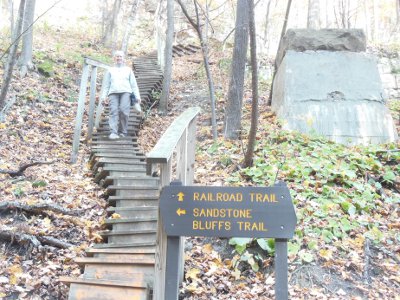

Walking south back to our car, the rail trail had very few people - we saw maybe a dozen. Much of the trail was through maple forest that had not yet lost its leafs. Whenever the wind blew, we were treated to a shower of rattling, golden foliage dropping to carpet the ground.
Where an old train tressle had been, we could see the footings and a staircase of 104 steps brought us to the bottom of a gully with the trail climbing back up the other side. But, at this point, there is a spur called the Sandstone Bluffs trail which adds 3/4 mile. Taking the spur was another very good decision.
Walking up the gully, filled with maple leafs on the ground and in the trees, felt like a walk through a golden cathedral. Viewing the sandstone bluffs, we got to see where new rock had been built upon the basalt bedrock and then carved away by the powerful, persistent work of water. Being higher on the hillside, there were also nice views across the river to Wisconsin.
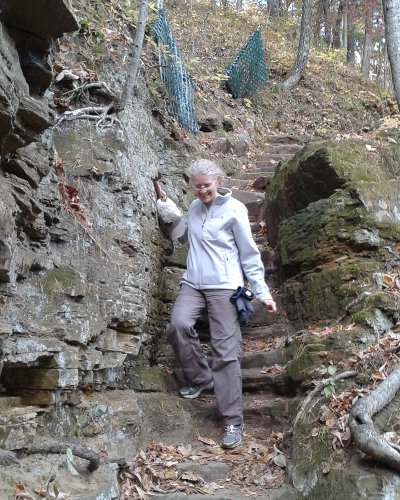

We really enjoyed the trail carved from rock, laid on the old rail bed, or built from wood - a lot of work goes into making and maintaining a trail like this that gets lots of traffic. I was very happy to see (or not see) no grafitti or scratchings in the soft sandstone.
The entire 3 mile hike was very nice.


The next day, we headed up Highway 53 in Wisconsin on our way to Duluth. Cruising along, I noticed a sign stating the North Country trail crossed the road ahead. Well, naturally, we stopped. A small kiosk with maps in a simple parking area invited us to go exploring. I had helped make a portion of this trail hundreds of miles away in western Minnesota a few years ago. Now, the trail stretches 4,600 miles from North Dakota through New York.
I've heard much of the NCT is difficult to navigate because it gets such little use. This section has been very well maintained, blazed, and signed. The NCT uses blue blazes on trees, or when crossing prairie, on posts. We got to experience both forest and prairie, hiking west from the trailhead towards Leo Creek campsite.
There is a trail registry at Leo Creek campsite. A trail registry is just a protected, blank book for hikers to sign in and leave their mark. There were less than a dozen hiker notes in this particular registry for the entire year. I guess that supports the claim that not many get out here on this trail.
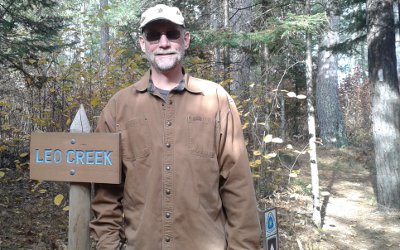

You might also notice the white blaze on the tree to the far right in this photo. White blazes indicate side trails on the NCT, such as to a campsite. It's important to know what colors are used on a trail, since white blazes mark the main path on the Appalachian Trail and blue means a side trail.
Being a long trail traversing the midwest, much of the NCT is relatively flat. This stretch had very little elevation, but gave up some nice views across bogs from low hills.
I was surprised at the lack of animals and birds, just a few red squirrels, today. That may have been due to the cool temperature and blustery wind. We were layered up and it was a comfortable day.
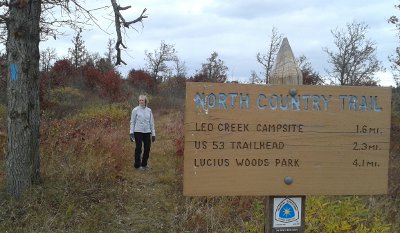

Having no destination, we just hiked. At about 2.5 miles, we decided to turn around. A dirt road crossing seemed as good a place as any to all the end point of our hike.
On this 50-mile section of trail, the map showed many camp sites and water was plentiful. I think I'll probably do a much longer hike on this trail soon, maybe North Dakota through Wisconsin would be a good distance.
In Duluth, we tackled our third and longest hike. The Superior Hiking trail follows the north shore of Lake Superior from Canada to the Wisconsin border south of Duluth. I hiked the northern 250 miles of it in 2012 because the southern 70 miles were not open yet. This was a chance to see what some of the trail is like.


We parked the car at the Martin Road trailhead north of Duluth. Heading into the mostly bare birch, maple, and oak forest, I couldn't help but wish we had been here last weekend instead. The bare trees did give a more open feeling and let in more sunlight on this cool morning.
The SHT uses blue blazes, like the NCT, but there are also plastic tags with the SHT logo and a blue directional arrow. These are helpful in parks where many trail crisscross. On the city streets, signage is sometimes challenging to find - it may be a faded blue splash on an old telephone pole, or a tag screwed to a stop sign, or a plastic sticker stuck on the back of a road sign.
Most of the SHT is out in the wild, but this 10 mile section tries to hide itself in thin strips of woods and parks as it works its way down to the shore of Lake Superior. After a nice woods walk, the official trail does a roadwalk through a large cemetary, then a mixture of short road and trail stretches. I found it to be a lot of fun.
It was probably fun for me because I let Mrs. Dude lead the way for much of the day. The trail was very well marked and only one road intersection was missing signage - we resorted to looking at the map on a cellphone after continueing on in the most obvious (but incorrect) direction for 1/4 mile.
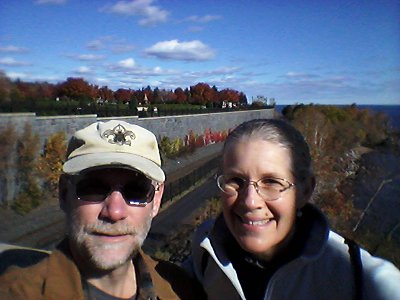

As I kept telling Mrs. Dude, today's trail is all downhill. We hiked from a high ridge down to the shore. The Lake Walk along Lake Superior takes hikers through the Rose Gardens, by a couple of micr-breweries and restaurants, and on to a hectic area called Canal Park. Being this was probably the last nice weekend, the place was a zoo! At least 1,000 people on the boardwalk, sidewalks, and grass.
It was a bad decision to ask our ride to pick us up here for the ride back to our car since the streets were gridlocked. Fortunately, we got ahold of him and met him on his way in, avoiding much of the hassle. It would have been better to stop at Fitger's Brewhouse - oh well.
Combining our three hikes, we covered about 18 miles and got to see a wide range of wonderful fall scenes and terrain left from the last glaciers.
Hike On
Mrs. Dude and I got out this weekend to tag three separate trails on three different days. We lucked into some perfect conditions and walked 18 miles of trail that was completely new to both of us.


On our first day, we visited Interstate Park on the Minnesota side of the St. Croix River - there's also an Interstate Park on the Wisconsin side. Parking at the southern access point, the trail along the river heads north 1.25 miles to the town of Taylors Falls. It's a nice trail, but runs between the busy road and the river, so it's noisy.
On this beautiful fall day, about 1,000 other people had our same idea. The trail was crowded which means a few oblivious folks blocking the trail to take a photo, others scrambling through vegetation, and dogs - lots of dogs. Small, yippy dogs that had to be carried because some of the rocks were too high for them to jump up. I'll never figure that out.
The vast majority of people were courteous and friendly and it was a very nice hike. The river trail winds through many rock cliffs, cuts, and formations, and there are some informational signs explaining the geology. At the north end of the trail, a visitor center has a lot more information that I found very interesting, especially the basalt rocks ground perfectly round from the river.


The St. Croix river was the low spot that gave way eons ago, allowing the glacial Lake Duluth to drain, leaving behind what is now Lake Superior. The raging water, filled with glacial silt, swirled in eddies and dug through the basalt bedrock around the Taylors Falls area, creating potholes. These aren't potholes as you'd find in a road. Some are big enough to walk through. This picture is looking up from inside Bake Oven Pothole.
Upon reaching the northern end, rather than heading back down the same trail (with our 1,000 friends), we made our way to the old railroad trail that parallels the river trail but on the other side of the road. This trail is higher up on the hill, and it was a very good decision!


Walking south back to our car, the rail trail had very few people - we saw maybe a dozen. Much of the trail was through maple forest that had not yet lost its leafs. Whenever the wind blew, we were treated to a shower of rattling, golden foliage dropping to carpet the ground.
Where an old train tressle had been, we could see the footings and a staircase of 104 steps brought us to the bottom of a gully with the trail climbing back up the other side. But, at this point, there is a spur called the Sandstone Bluffs trail which adds 3/4 mile. Taking the spur was another very good decision.
Walking up the gully, filled with maple leafs on the ground and in the trees, felt like a walk through a golden cathedral. Viewing the sandstone bluffs, we got to see where new rock had been built upon the basalt bedrock and then carved away by the powerful, persistent work of water. Being higher on the hillside, there were also nice views across the river to Wisconsin.


We really enjoyed the trail carved from rock, laid on the old rail bed, or built from wood - a lot of work goes into making and maintaining a trail like this that gets lots of traffic. I was very happy to see (or not see) no grafitti or scratchings in the soft sandstone.
The entire 3 mile hike was very nice.


The next day, we headed up Highway 53 in Wisconsin on our way to Duluth. Cruising along, I noticed a sign stating the North Country trail crossed the road ahead. Well, naturally, we stopped. A small kiosk with maps in a simple parking area invited us to go exploring. I had helped make a portion of this trail hundreds of miles away in western Minnesota a few years ago. Now, the trail stretches 4,600 miles from North Dakota through New York.
I've heard much of the NCT is difficult to navigate because it gets such little use. This section has been very well maintained, blazed, and signed. The NCT uses blue blazes on trees, or when crossing prairie, on posts. We got to experience both forest and prairie, hiking west from the trailhead towards Leo Creek campsite.
There is a trail registry at Leo Creek campsite. A trail registry is just a protected, blank book for hikers to sign in and leave their mark. There were less than a dozen hiker notes in this particular registry for the entire year. I guess that supports the claim that not many get out here on this trail.


You might also notice the white blaze on the tree to the far right in this photo. White blazes indicate side trails on the NCT, such as to a campsite. It's important to know what colors are used on a trail, since white blazes mark the main path on the Appalachian Trail and blue means a side trail.
Being a long trail traversing the midwest, much of the NCT is relatively flat. This stretch had very little elevation, but gave up some nice views across bogs from low hills.
I was surprised at the lack of animals and birds, just a few red squirrels, today. That may have been due to the cool temperature and blustery wind. We were layered up and it was a comfortable day.


Having no destination, we just hiked. At about 2.5 miles, we decided to turn around. A dirt road crossing seemed as good a place as any to all the end point of our hike.
On this 50-mile section of trail, the map showed many camp sites and water was plentiful. I think I'll probably do a much longer hike on this trail soon, maybe North Dakota through Wisconsin would be a good distance.
In Duluth, we tackled our third and longest hike. The Superior Hiking trail follows the north shore of Lake Superior from Canada to the Wisconsin border south of Duluth. I hiked the northern 250 miles of it in 2012 because the southern 70 miles were not open yet. This was a chance to see what some of the trail is like.


We parked the car at the Martin Road trailhead north of Duluth. Heading into the mostly bare birch, maple, and oak forest, I couldn't help but wish we had been here last weekend instead. The bare trees did give a more open feeling and let in more sunlight on this cool morning.
The SHT uses blue blazes, like the NCT, but there are also plastic tags with the SHT logo and a blue directional arrow. These are helpful in parks where many trail crisscross. On the city streets, signage is sometimes challenging to find - it may be a faded blue splash on an old telephone pole, or a tag screwed to a stop sign, or a plastic sticker stuck on the back of a road sign.
Most of the SHT is out in the wild, but this 10 mile section tries to hide itself in thin strips of woods and parks as it works its way down to the shore of Lake Superior. After a nice woods walk, the official trail does a roadwalk through a large cemetary, then a mixture of short road and trail stretches. I found it to be a lot of fun.
It was probably fun for me because I let Mrs. Dude lead the way for much of the day. The trail was very well marked and only one road intersection was missing signage - we resorted to looking at the map on a cellphone after continueing on in the most obvious (but incorrect) direction for 1/4 mile.


As I kept telling Mrs. Dude, today's trail is all downhill. We hiked from a high ridge down to the shore. The Lake Walk along Lake Superior takes hikers through the Rose Gardens, by a couple of micr-breweries and restaurants, and on to a hectic area called Canal Park. Being this was probably the last nice weekend, the place was a zoo! At least 1,000 people on the boardwalk, sidewalks, and grass.
It was a bad decision to ask our ride to pick us up here for the ride back to our car since the streets were gridlocked. Fortunately, we got ahold of him and met him on his way in, avoiding much of the hassle. It would have been better to stop at Fitger's Brewhouse - oh well.
Combining our three hikes, we covered about 18 miles and got to see a wide range of wonderful fall scenes and terrain left from the last glaciers.
Hike On
10/19/2015
My Friend, Thelma


Building a National Scenic Trail takes much more than a handful of volunteers, but without a handful of dedicated, driven, selfless volunteers, none of our trails would have ever been established. There is often an individual with a dream who gets his/her name tied to a trail as the founder, such as Benton Mackaye, Clinton Clarke, Ron Strickland, or Ray Zillmer. Long after the first dream of a trail, definition of a route, and government designation, armies of volunteers actually build our National Scenic Trails. And, behind that army of workers, there are even more people supporting their labors. That is where this story takes place - armies of volunteers performing thousands of hours of physical labor require millions of calories.
This past weekend of hiking was highlighted by a short visit with a wonderful lady, in a tiny cafe, in a small town, in the state that is home to the Ice Age National Scenic Trail. Her name is Thelma Johnson from Cumberland, WI and she is one of that dedicated handful of volunteers that make things happen.
The Ice Age Trail Alliance plans a few 3- to 5-day Mobile Skills Crew projects each year, specifically aimed at educating trail volunteers in trail construction and maintenance skills through hard, dirty hands-on training. The typical 20 to 80 participants can then help lead smaller trail projects locally. As you can imagine, that many people working for that many days can consume a tremendous amount of food.
Thelma's niche role for the past 12 years has been feeding all these MSC participants three meals a day. That's roughly 200 meals a day, 1000 meals per project, and she's served well over 30,000 meals now. These meals are prepared outdoors, wherever the trail needs work, so Thelma is right out there in whatever weather comes along, making sure the volunteers have energy for the day.
At each project, Thelma has kitchen helpers she is responsible for organizing. Since they are often new volunteers needing direction, just like the newbie trail builders swinging axes, shovels, and macleods, Thelma puts in long hours of OJT, cooking, and clean-up. Long after the last meal is served, she'll still be cleaning in preparation for the next day. And, her day on the trail normally starts around 4:30am to have breakfast ready for her trail family.
Oh, did I mention that Thelma is over 80 years in age. That's right. That means she started volunteering with the IATA at about 70 years old. I was curious how someone starts something like this at that age. As it turns out, Thelma saw a notice in the paper from the IATA that a trail work project was being held near her home. Having nothing more pressing to do, she showed up, they gave her a rake, and she raked the trail route all day. She soon turned in the rake for an apron, and has been cooking up a storm ever since.
As the IATA's Mobile Skills Crew program has grown, more projects are held, more volunteers are involved, and more cooking is needed. Thelma still fills her Prius to the roof with gear and food and drives to the projects, but the IATA now has a very cool kitchen trailer that makes meal prep a bit more efficient.
This year, in recognition of her many hours, and years, of volunteer service, Thelma received the National Park Service Hartzog Enduring Service Award. She traveled to Washington, DC to receive her recognition in June, but I expect the high fives and thank yous back home on the trail in Wisconsin this past summer were even more important to her. She told me that it thrills her to know the trail volunteers love her and appreciate what she does for them.
At the National Park Service site, you can view a video about the 2014 Hartzog winners. The first 30 seconds feature Thelma!
I mentioned that Thelma started volunteering with the Ice Age Trail folks at about 70 years. Well, she does much more than just cook. At about 80 years, she has taken on a new, farther reaching project. Thelma traveled to Quatro, Manila in the Philippines recently and experienced the plight of some mothers struggling to survive. She has supplied them with sewing machines, training, and fabric so they can create and sell products to support their children. Now, Thelma visits them a few times each year to teach new sewing skills and get their wares to market. All of the money raised goes to the families since Thelma covers her own travel costs.
Please take a look at the aprons and items the Quatro Ladies create at Quatro Ladies on etsy.com - maybe you know a kitchen magician that could use a new apron?
Thelma is a joy to spend time with, and has a contagious, positive outlook that spawns smiles and hope around her. I can hardly wait to see what mischief she gets into at about 90 years. Thanks for all you do, Thelma!

Leave Comment
Posted: 10/19/2015
Posted: 10/19/2015
10/09/2015
Fears vs. Dangers
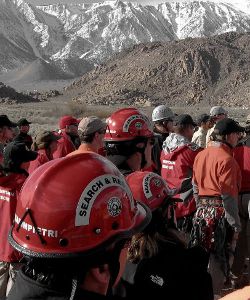
 When I first told friends and family that I would be going on some long hikes, it was interesting what dangers they came up with that I should be worried about and protect myself from. Now, after hiking a few thousand miles, I can confidently compare what their fears were about with what real dangers exist. The two do not match up very well.
When I first told friends and family that I would be going on some long hikes, it was interesting what dangers they came up with that I should be worried about and protect myself from. Now, after hiking a few thousand miles, I can confidently compare what their fears were about with what real dangers exist. The two do not match up very well.Now, I do realize that a person CAN die or be severely injured out in the wilds, and any of the things listed below COULD be the cause, but it's all about keeping a reasonable perspective.
Here are my lists of "Fears" that people are often concerned with, and Dangers that they really should be ready for...


"Fears"
- Bears - Bears are waiting around every corner, behind every tree, under every bush just waiting to jump out and maul you to death.
Really, you'll be lucky to see a bear. I've seen 6 so far. They run away. See Bears. - Cougars - puma, panther, mountain lion, catamount, whatever you call them, they will silently stalk you and then attack in the blink of an eye and it's all over.
Really, you'll never see one. If you do, you'll be an instant celebrity in the hiking community. But, there have been a couple dozen cougar deaths in the past century, mostly small children - see Cougars - Murderers - You're all alone out there, and there are murderers, rapists, thieves, and weirdos waiting to do you in.
Really, no one will hike miles and miles into the wilderness just so they can kill someone, and no backpacker has anything worth stealing. Now, on trails that go through populated areas, like the Appalachian Trail and Ice Age Trail, it's possible to run into trouble from bored locals around trailheads and in towns, but I've met nothing but friendly, helpful folks.
For perspective, there have been about a dozen murders on the A.T. over the past 40 years - in just Atlanta (at the south end of the A.T.) there were 84 murders in 2013 alone. - Snakes - Every rock, hollow log, and empty hiking boot hides a vicious snake, coiled and ready to strike as soon as you get close.
Really, venomous snakes want nothing to do with humans but they are common in some areas. A handful of people die from snakebite each year in the USA, but very few of them are hikers. See Snakes. - Spiders - They're creepy, ugly, scary, and out to suck your blood, and they're everywhere!
Really, similar to snakes, spider bites kill just a handful of Americans each year, and virtually none of those are out backpacking. There's a small chance you'll get a spider bite, but chances are good that what you thought was a spider bite was really a fly, gnat, chigger, flea, bedbug, or any other creepy crawly.
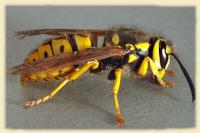

Dangers
- Gravity - More people die from falling, or things falling on them, in the backcountry than anything else. To minimize the danger, stay on the trail and be aware of your surroundings, especially potential rockfalls, dead trees, and avalanche areas.
- Rain - Rain, wind, and dropping temperature can make for miserable or deadly conditions. You will encounter rain. You will get wet. This can be the most dangerous situation for unprepared hikers. To minimize the danger, be prepared with layered clothing, protective outer shell, and skills to stay warm when wet.
- Foot Injuries - Blisters, bruising, twisted ankles, inflamed joints, and just plain wearing out from pounding on rough, uneven terrain all day is most likely the thing that will hurt your body. Whether it's because of poor shoes, inadequate training, wet socks, or just one mis-step, if your feet don't work, you can't hike. To minimize the danger, practice hiking short distances, in the shoes you'll wear on the longer hikes, to prepare your muscles, joints, and skin for the wear and tear they will receive. Also, go at a slower pace and for shorter distances when first starting a longer trail.
- Spider Webs - OMG! By far the most annoying thing EVER on the trail! Orb weaver spiders spin webs across the trail every evening. Hiking through forest, you're guaranteed to run facefirst into dozens and dozens of webs every day - unless you have a tall hiking partner walk ahead of you. Problem solved! I'd buy a device that attaches to your hat and hangs out in front of you to catch the webs - let me know if you hear of one.
- Mice - Far worse than bear and cougar, these varmints chew through $$$$$ worth of gear, spread disease through their waste, gnaw holes in food bags and ruin food. Plus, they scurry over your face, arms, and legs during the night.
The best thing to do is camp away from people, in your own tent, with your food hung from a high tree limb. - Insects - Whether it's getting bit by ticks or mosquitoes, stung by bees, yellow jackets, or wasps, or just bothered by gnats and flies buzzing your head all day, insects are everywhere outdoors. A rare few hikers may catch a bad disease, some may have allergic reactions, many will get infections, but all of us will experience pain, itch, and discomfort from the tiny wounds they leave behind. To minimize the danger, hike in the cold winter! Or, wear mesh outer layer, long pants and sleeves, or use bug repellant.
- Lightning - Well, the chances of dying from lightning are pretty low, but about 10x as likely as dying from snake bite. Lightning is sporadic and random - there is no place outdoors that is safe from lightning. To minimize the danger, pay attention to the developing weather and get indoors before a storm. Unable to do that, understand basic lightning safety suggestions.
- Filth - When everything in your gut is coming out in ways it shouldn't, most people assume they drank bad water. That's certainly possible, especially for those that don't even bother treating water, but it's more probable that bacteria from poop got on their hands, and then onto their food, and then into their mouths. That poop residue can be abundant on highly used trails, especially with established campsites or shelters that have designated latrines.
To minimize the danger, wash your hands often, keep your fingernails short and clean, and use alcohol-based hand sanitizers after washing.
What did I miss? Anything else out there that scares you about being in the outdoors, or that we really should be concerned about?
Hike On
10/05/2015
Florida Trail Partner Needed
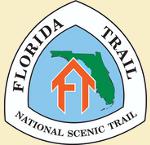

Hey, wanna hike the Florida Trail with me?
I'm planning to thru-hike the Florida Trail starting around Jan. 8 heading northbound. That's because it looks like the Florida Trail Association is setting that as their 2016 Kick-Off date and a few other people are starting then. But, I'd be happy to go southbound, or start a different day around that time, whatever works.
I know many people do thru-hikes alone, but I don't care for being alone on the trail for weeks at a time. A 1-week solo trek is fun, but longer than that and I don't enjoy it. Some folks hike long trails to find themselves, to get in touch with nature, or to overcome some challenge. Well, I know me, I'm very comfortable in nature, and I see a trail as an adventure rather than a challenge. So, I'm sincerely looking for someone to hike this trail with me and share the adventure.
If you're interested, and to improve our chances of being a good fit, here is some info about how I hope to hike the trail. Hopefully, this gives you a feel for what to expect and you will consider joining me:
- Hike 25 miles per day on average. In early January, there are about 11 hours of hikable daylight in FL, extending to 12 hours by mid-February.
On this extremely flat trail, with many road, levy, dike miles, I expect to walk around 3MPH much of the time. Hiking about 3MPH for about 8 hours, with a morning, lunch, and afternoon break gets 25 miles done handily in 11 hours.
Some trail challenges will certainly be much slower, even 1MPH for some of the swamp slogs, so some days will be shorter distances. - Take a Nero Day each week. Hiking 150 miles in 6 days, followed by a day of rest, breaks the trek into a bunch of shorter week-long backpacking trips.
Smaller bites like that are easier for me to handle.
A Zero Day is taking a day off trail to rest legs and feet, and to resupply, wash clothes, and shower. This often results in hiking into a town, getting a hotel room, resting a day, and staying in the hotel a 2nd night. A Nero Day is similar, but cheaper. Camp a few miles from town so it is a short walk in the morning. Get a hotel, do chores in afternoon and evening. Sleep in and relax until late the next afternoon, then hike a short distance to camp that night. You get pretty much the same rest and fresh food, but pay for only 1 night. - Complete the trail in 50 days. 25MPD * 6 days = 150 days/week. 1,100 miles / 150 = 7 weeks = 50 days. That includes 7 rest days, too.
- Hike early. I like to get up at first light, pack up, and start hiking. I'm usually not really hungry first thing, and I don't do coffee.
Hiking early lets me see lots more wildlife, it's a cooler temperature, and daylight is precious in January. - Hike Together or Apart. I enjoy hiking within eyesight of my partner and talking while on the trail, but in 7 weeks we'll surely want time hiking alone. I would like to at least have a check-in at mid-day and at the end of the day, so we'll know if one of us does not make it.
- Planning. I create a plan for my entire trek before leaving home. This gets me introduced to the terrain, water sources, resupply options, and probable camping spots for each day. As soon as I set foot on the trail, that plan is no longer used - it was just an exercise to prepare.
I am comfortable having a general, flexible plan for the week ahead and a specific plan for the next day. That daily plan includes an idea of how many miles we'll do, any weirdness ahead on the trail, potential water sources, and probable camping spot.
I'll have a Florida Trail guidebook along which is so important for planning the days ahead. - Use of Technology. I use a cellphone for my camera, gps, navigation app, and blog. It is usually in airplane mode and silent. I blog from the trail which usually means making a text message on my phone at the end of the day. I have a SPOT Messenger that tracks my location and sends for help in an emergency - it makes no noise and only sends out data blips. If you have family at home wanting to follow your progress, this works well.
- I do my very best to follow Leave No Trace principles, and I'm an educator in that topic. That means I'll have a hard time with litter, destroying plants, and harassing animals.
- I'm involved with the Boy Scouts, Red Cross, and Lutheran church. So, if those areas bother you, we're probably not a good fit.
- I don't smoke or do drugs, and I don't want to be around either. I don't do coffee, but don't mind it. Alcohol in moderation is fine with me.
OK, what do you think? Can you meet me in Florida for 50 days of adventure? Or, maybe you'd like to hike halfway and stop at DisneyWorld in Orlando? Or, maybe you prefer doing a section and join us for a few days somewhere on the trail?
Please Send me Email if you want to pursue this adventure.
Hike On
09/18/2015
A.T. Winner

 On my 300-mile section hike of the Appalachian Trail, I met many interesting folks and had some wonderful (and some challenging) times. Every day offered up at least one memorable moment, but my evening spent in the Gravel Springs hut in the Shenandoah National Park was certainly one of the favorite times on my trek.
On my 300-mile section hike of the Appalachian Trail, I met many interesting folks and had some wonderful (and some challenging) times. Every day offered up at least one memorable moment, but my evening spent in the Gravel Springs hut in the Shenandoah National Park was certainly one of the favorite times on my trek.Just before reaching the shelter, I met a National Park Service ranger (with a gun) that was investigating pilfering of Gensing in the park. He was an Eagle Scout, too. If you are interested in that story, check out my A.T. Journal for details.
When I walked up to Gravel Springs, there were already 4 people there. This usually means a crowded, often sleepless, night. But, these 4 were wonderful.
A Boy Scout and his dad, and a Girl Scout and her dad, from Maryland were out for a few days of backpacking. Right off the bat, they welcomed me, made room at the picnic table, and made me feel right at home.
They made some freeze-dried dinners for their meal and had too much to eat (or so they insisted), so they shared with me. They also made a campfire which was nice for drying out soggy clothing. And, I got to tell two of my favorite stories - #1 and #2. The Girl Scout wanted to know if the second one was true, so that was a bonus. :-) But hey, this Girl Scout is awesome - she loves being outdoors, is self-sufficient, and will do great things in her life, I'm sure.
It was just a great evening, and one of those that I'll think about often.
I said I would send a Scout Shop gift card to some Scout or Scouter that I got to hike with on my A.T. trek, or at least met on the way. In my 300 miles, I met this Maryland scout, two other scouts, and 3 Scouters. Oh, and 3 Eagle Scouts that were backpacking as part of some Washington & Lee University outdoors program trips.
Anyway, this MD scout was chosen as the winner and I've sent him a $25 Scout Shop gift card. He's a young Star scout and has big plans for some high adventure trips over the next couple years, so I expect he'll have no problem spending it.
Hike On
Older Posts Newer Posts
Find more Hiking Resources at www.HikingDude.com


Follow Me
Recent Comments